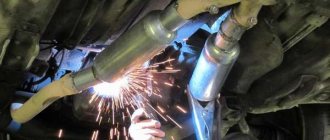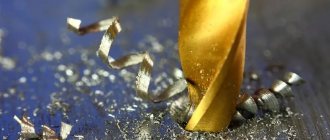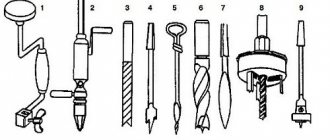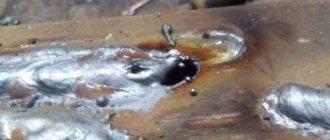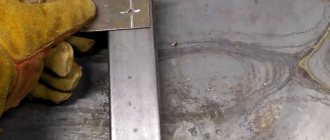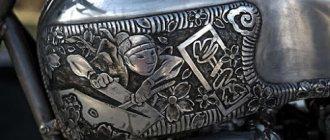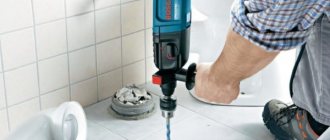The main purpose of any welding machine is to weld metal. But there are also minor operations that can be performed with its help. In industrial conditions, powerful power sources are used for gouging (to organize it you will also need a compressor and a carbon electrode, read more here). In the garage, when performing household work, an MMA welding inverter can be adapted for cutting, for example, if you need to cut a non-standard hole.
How to cut metal with an electrode correctly
To get a smooth, clean cut, you need to cut vertically. When cutting horizontally, i.e. in the lower position, a burr is formed that hangs down. If you want to get a neat hole, you need to set the current low, but if the correct geometry of the cut is not important, you need to set the current higher.
How to make a hole
a) The steel is heated and immediately pressed by the electrode;
b) To make a smooth hole, the metal is heated and the electrode moves in a circle. After some time, the resulting bath will either fall by itself, or it will need to be pushed a little.
Add a comment Cancel reply
You must be logged in to post a comment.
Is it worth BUYING, reviews from welders:
- Welding transformer PATRIOT 200AC 102.00 RUR
- Charger GreenWorks G24C RUB 2,490.00
- Voltage stabilizer PRORAB DVR 1000 2597.22 RUR
- Stabilizer Resanta ASN-2000 N/1-C Lux 3610.00 ₽
- Voltage stabilizer Stavr SN-2000 3920.00 RUR
- Welding machine BauMaster AW-79161 3990.00 RUR
- Hitachi AB17 charger RUB 4,076.87
Every beginner and even an experienced welder burned through metal while welding. This is either due to a large current, or due to a very thin sheet, or due to both. Metal cutting is carried out using this property. It is most convenient to cut a sheet or product using manual arc welding, that is, an electrode.
Electric welding, of course, cannot cut metal like plasma, laser or grinder, but such cutting still exists and is used quite widely. It is mainly used where very precise cutting of metal . Cut off, for example, an extra piece of reinforcement or stainless steel. For such cutting, nothing is needed except electrodes and a welding machine. You can cut very thin and thick materials; the thickness of the metal being cut depends on the current strength. If you have a powerful device and strong electrical wiring, you can cut until the electrode in the holder melts.
Cutting thin and thick sheets occurs slightly differently. When cutting thin metal, the current increases, approximately twice as much as usual. The electrode should be closer to the workpiece and go deeper into the cut. It is as if excess metal is blown off by welding. Everyone can do this. But getting the cut edges to be relatively straight takes practice. Thick sheets are cut almost the same way. The current is added depending on the thickness you want to cut. When cutting, you will need to blow through more thickness. To do this, you will need to deepen the electrode into the molten metal, pushing it out until you can see that it has been cut all the way through.
When cutting metal by electric welding, old, unnecessary electrodes of the required diameter are usually used. If you are cutting thin metal, then an electrode with a diameter of 3 mm or three is quite suitable for you, and for a thicker sheet a four or five is required.
Plasma cutting services for various metals, as well as their alloys, are very popular. Plasma cutting makes it easy to cut stainless, carbon and high-alloy steel. We also often accept orders for plasma cutting of titanium, aluminum, brass, copper, bronze, cast iron and products that combine several types of alloys. Excellent quality and fast order fulfillment are guaranteed by many companies providing similar services. Metalworking services are also provided, and a wide range of metal products are produced according to customer drawings with the necessary equipment and a staff of craftsmen, whose qualifications allow us to fulfill orders at the highest level of quality in a short time.
For cutting metal
In the future, using the position of the electrode, you can successfully cut steel. Molten metal is removed from the cut site by arc pressure and its own weight. Sometimes it is additionally blown out with a stream of air.
In this way, by exceeding the welding current by up to 30% and using ordinary welding electrodes, metal parts can be cut. True, the quality of the resulting walls will be low, and the edges will be melted and covered with slag. For further use, they will have to be processed with mechanical tools. But in many cases this is simply not required.
The arc cutting method can be used when placing a part in different planes. This is convenient when performing installation and repair work.
If it is necessary to improve the conditions for the flow of metal from the cut site, then after orienting the position of the part in space, a second welding cable is used to create a magnetic field that deflects the position of the arc. An additional cable is attached to the top near the beginning of the cut.
It is convenient to cut parts in this way from the edge or cut hole. The angle of inclination of the electrode is selected depending on the thickness of the metal being cut. It is convenient to process thin sheets at a right angle of inclination, while sharp angles are suitable for thick parts.
If you place the electrode at an acute angle of up to 20 degrees, you can melt grooves in the metal. To do this, move the end of the electrode immersed in the metal and create small vibrations in the vertical direction. By varying the speed of movement of the arc with the angle of inclination, you can choose the depth of the groove. It is quite acceptable to make several passes to increase it.
If it is necessary to burn round holes, the electrode is placed at right angles to the surface and an arc of maximum length is created. If you need to increase the size of the hole, then step back from its edge and expand the slot in a circular motion.
Conventional electrodes burn out very quickly during such work. Therefore, for long-term use, special electrodes for metal cutting are produced, which allow better cutting of cast iron, steel of all grades and non-ferrous metals. The OZR-1 and OZR-2 brands have universal qualities and are popular. Their operational capabilities have been assessed by many experts.
You can cut metal using arc welding using different electrodes; each welder independently chooses the brands that suit him best. But a good craftsman always has specially manufactured and tested electrodes in stock for high-quality performance of important work.
What should you have on hand?
To make a hole in metal, you must have an inverter, electrodes, as well as a hammer and a brush with metal bristles.
Inverters come in different types: cheap and expensive, professional and household, powerful and not very powerful. In essence, it does not matter which inverter you use for cutting. The main thing is that it is in good order.
As for electrodes, there is a wide choice. Previously, cutting was performed with the same electrodes as welding. But now there are many brands on sale that are designed specifically for cutting. They are all good in their own way. The most popular brand of cutting electrodes is OZR. They provide a more or less even cut and allow you to get the job done quite quickly.
If you decide to use conventional electrodes for welding, then be prepared that the cut will not be the most aesthetically pleasing, and the work itself will proceed more slowly, and the arc will burn unstably.
Welding current
What about welding current? As you, I hope, have already understood, the higher the welding current, the more energy is transferred to the welding zone, the stronger and deeper the metal melts and the thicker the products you can join. And to transmit a greater current, a thicker conductor is needed. Accordingly, we can reach a direct relationship: metal thickness - electrode thickness - current strength. Welding machines are often marked with signs corresponding to the thickness of the electrode and the welding current. I recommend that you do not take such tables as dogma - they are just a starting point to guide you. For household use, a current of up to 160A is sufficient, which allows you to use a 4 mm electrode. In my memory, I very rarely used this diameter of electrodes. Basically it is 2 and 3 mm. There is also a diameter of 2.5 mm for electrodes of the UONI-13/45, 15/55, NIAT-3M brands (types for carbon steels). Approximately the strength of the welding current can be determined by the formula: I=Kdel. Where K is an experimental coefficient equal to 40-60 mm for electrodes made of low-carbon steel and 35-40 mm for electrodes with a rod made of high-alloy steel, and del is the diameter of your electrode.
Selection of modes and electrodes
The current strength used in such work directly depends on the thickness of the parts and the diameter of the electrode.
Thin metal is considered to be workpieces up to 5 millimeters thick. However, welding problems occur with parts up to 3 mm. In the table you can see the approximate correspondence of the selected power to the material and electrode diameter.
These are approximate data; more precise settings of the device can be determined experimentally by trying to weld metal.
When using thin types of electrodes, you need to take into account that their melting rate is higher, which means you need to weld faster.
The main requirements for the selection of consumables are the same as for welding standard structures. The electrode coating and composition must match the metal being welded.
Metal cutting by welding, welding machine, burning
Now let's speculate - what happens if we take an electrode with a diameter of 2 mm for a sheet of steel 2 mm, and set the current to about 100A, which usually corresponds to an electrode diameter of 3 mm? What will happen is that the electrode and steel will begin to actively melt and evaporate. The electrode will have to be supplied very intensively to the welding zone. You won't get any bath, but you will get the so-called. through burning. It seems like a nuisance, but let’s turn it into a good thing - we’ll start moving the electrode progressively, controlling the occurrence of burnout. And lo and behold, we cut steel! Moreover, in this way you can cut a fairly thick-walled sheet. Of course, the quality of the edges will be much lower than when cutting with an angle grinder (grinder), but this method is sometimes quite applicable when high demands on the quality of the edges are not made. The current for cutting metal is usually 25-30% higher than the current required for welding.
Welding techniques for thin-walled structures
Overlapping. If the design allows, the sheets can be placed one on top of the other. In this case, the main thing is not to burn the surface located below.
Point connection. Technologically, such a seam is made in the form of local tacks. The arc is ignited, the metal is boiled in the right place and extinguished. And then, throughout the entire connection, in increments of 3 electrode diameters, everything is repeated.
Also, for welding thin-walled structures, reverse polarity can be set. When the holder cable is set to positive and the ground to negative. Reversing the polarity reduces the amount of heat at the electrode tip and will help avoid burn-through.
If you need to weld a massive part with thin metal, then the arc is ignited on a thick-walled workpiece and in the process the weld is transferred to the joint.
To remove excess heat, a copper strip can be placed under the thinnest parts. Copper is a very heat-intensive material and will avoid burning and leakage of molten metal.
What do you think about this type of work, such as welding of thin sheet metal? If you have extensive experience in welding joints made of thin material, share it in the comments to this article.
Electrode position during welding. Electrode holder, holder
You insert the electrode into an electrode holder (welders call it a 'holder'). It should be comfortable, lightweight, and have grooves for installing the electrode at different angles. There are many different electrode holders in design and application. As a rule, well-known manufacturers equip welding machines with quite decent electrode holders, and you do not need to think about their modifications. When you insert the electrode into the holder, be sure to check (by rocking) that it is securely fastened in the holder. Otherwise, sparking will occur at the attachment point and your arc will either be unstable or not ignite at all.
So how do we hold the electrode? In relation to the seam plane, it can be at an angle of 30-60° from the vertical, or at a right angle. When making vertical seams from bottom to top, the angle should be 45-50° down from the horizontal. If from top to bottom - 10-20° down from the horizontal. In addition, the process is determined by the direction of movement. When welding at an angle 'forward' (away from you), the depth of penetration decreases, the height of the convexity of the seam decreases, but the width of the seam noticeably increases, which makes it possible to recommend this position for joining metals of small thickness. In this case, the melt and slag moves ahead of the electrode. This method has a number of disadvantages - for example, a lot of liquid slag accumulates in front of the electrode, it flows onto the metal and interferes with maintaining the arc. Lack of penetration and slag inclusions are possible. In this case, it is necessary to align the position of the electrode to vertical.
Generally speaking, you will observe how the metal flow and arc 'repel' the melt in the weld puddle and will observe differences at different electrode positions.
'Right angle' welding (the electrode moves away from you) allows the liquid slag to follow the weld pool, covering the liquid weld metal just behind the electrode. This ensures the formation of a high-quality roller.
In addition, when welding with rutile-coated electrodes, the inclination of the electrode towards the future weld should always be greater than for electrodes with a basic coating.
Problems of welding thin-walled products
The main problems that arise in the process of welding thin metal with electrodes are similar to ordinary defects due to poor-quality connections.
- Burning the workpiece.
- Electrode sticking.
- Unwelded seam.
- Material deformation.
Burning is the most common phenomenon when working with thin-walled structures. This is a consequence of incorrectly selected current strength. It is the excess power that contributes to the rapid melting of the metal and the formation of holes.
Electrode sticking occurs in two cases: at low current and when the tip of the consumable is brought close to the metal surface. These two negative factors contribute to the formation of an uneven joint and, as a result, the quality of welding decreases.
An underwelded seam is a common mistake made by beginners in welding. For fear of burning through the metal, the tip of the electrode is removed a long distance and the melt simply spreads over the surface. As a result, during stripping it turns out that the seam is uneven and there are areas that are not connected.
Deformation is also a fairly common occurrence when welding thin sheet metal. This is a consequence of exposure to high temperatures.
How is welding of thin metal carried out and what are the ways to solve the problem of defects?
cut metal using electric welding
This causes the weld metal to cool quickly. This negatively affects the quality of the seam. The seam is uneven, with scales and significant differences along the edges to the base metal. It is necessary to maintain such an angle that the liquid slag follows directly behind the electrode and is not displaced by the arc force.
(read more...) :: (to the beginning of the article)
Unfortunately, errors are periodically found in articles; they are corrected, articles are supplemented, developed, and new ones are prepared. Subscribe to the news to stay informed.
If something is unclear, be sure to ask! Ask a Question. Discussion of the article. [4] messages.
'Since the electrode-product polarity changes 50 times per second, this causes...' mmmmmm, that is, you are not aware that the frequency of the alternating current is 50Hz, which does not mean a change of 0/phase 50 times per second. Or do you also think that '+' is the flow of protons, and 'minus' is electrons? In general, I thought that the zero is connected to the product, and the phase is supplied to the electrode. Read the answer...
I myself have been working as a welder for 25 years. I can do everything, but I’m not very good at explaining. Now my son has decided to follow in his father's footsteps. I searched the Internet for material to learn the basics. And settled on yours. Thank you. Read the answer...
Inaccuracy in polarity: direct polarity part '+' electrode '-', reverse polarity respectively part '-' electrode '+' Read the answer…
I welded a frame for the door leaf, size 2.2x1.2 (m). How to properly weld a sheet (2mm thick) so that it does not “pull”. Read the answer...
Why does concrete crumble, crack, or deteriorate in the foundation, walkway,... The path and foundation were poured in the summer. After winter, serious damage is visible, observing...
Do-it-yourself garden bench at your summer cottage... Design of a garden bench. How to make a comfortable bench in your country house with your own hands...
Fence posts, DIY fences. Put up, install, dig in... Fence posts, fences. We will make a good support for the fence so that the fence will last...
How to eliminate a leak in the heating system, heating boiler... What to do with a small leak in the heating system?…
Let's connect aluminum and copper wire. Cable, wiring. Apartment, house, ... How to connect aluminum and copper wire? Connection of copper and aluminum wires…
Malfunctions of infrared (IR) remote controls... The remote control began to act up, stopped working, and broke down. Pe…
Homemade thermal bag with a cold accumulator (cooling element)… How to make a cooler bag and cooling elements for it with your own hands…
Grounding a laptop or TV to prevent electric shock... How to ground a household appliance in a plastic case: laptop, TV and others...
View Queue
Queue
- delete everything
- Disable
ortodox69 › Blog › welding thin sheets with an inverter (summary note)
Thin-sheet is a material with a thickness of up to 5 mm
Since the welding process is performed by an inverter exclusively using low current, even a slight gap in the working distance between the part and the electrode should not be allowed.
Otherwise, a break in the electric arc cannot be avoided.
The electrode must have a small thickness
If you weld thin metal with an inverter and at the same time maintain a small arc gap, then the welded seam joint will be convex for the reason that the main part of the metal does not heat up well.
A high-quality seam can be achieved through circular and zigzag movements of the electrode along the surface to be joined.
If you move the electrode too vigorously during the welding process, then all that can be achieved is a deformed joint.
for sheets of thin metal with a thickness of up to 1.5 mm, products with a diameter of 1.6 mm should be used.
The current strength during inverter welding of metal sheets should not exceed 40 Amperes.
In the process of welding thin-sheet metal products, spot or intermittent welding technology can be used.
Due to the short operation of the arc, tacks are formed, subsequently the electric arc is extinguished, then the process is repeated at a distance equal to the size of 2 or 3 electrode diameters.
PS: I just tried to cook MP-3C 3 mm with rutile coating, I’ll immediately say that the “+” on the mass-burns is significantly less than when “+” is on the electrode! Cooked thin iron.
Comments 413
What happens if you weld a horizontal seam using movements 1?
An inert gas environment allows you to keep the arc more stable; in simple welding, this is achieved by the composition of the electrode coating. The smaller diameter of the electrode in an inert gas reduces the thermal load on the part outside the weld zone (and this is even better in resistance welding). It will rot both here and there if it is not treated after welding.
I myself once cooked a threshold of 0.8mm, by touching, the electrodes were Esab, 3mm, current 35-40A (sometimes I changed it). These electrodes do not go out at low currents, like holding a pencil, and they burn, but do not splash. Combustion doesn’t even look like welding with an electrode... OZS-2 and ANO-21 did not allow me to achieve such a result.
Why do all the craftsmen weld bodies semi-automatically, and not with electric or gas welding?
With an electrode, the metal burns through, it warps, the seam is crooked, it slags, etc., but with a semi-automatic welder you can even cook foil - the seam is even, it cooks completely, it does not lead to metal, etc. And if you need to boil something thicker, arc welding is the way to go!
Metal does not lead if you grab a lot of points correctly.
Let me remind you that in the best case, the car body is 1 mm (this is literally a tank-shaped zil), a typical case is 0.6-0.8 mm, and in the average case, when the body is already being cooked to a level of rust, this layer after cleaning off rust is reduced to 0. 4 mm. So it’s not that it’s impossible to weld a body with an electrode, it’s almost impossible.
I don’t know, a relative was welding cars for a year while they were using a semi-automatic trans for him... Why did he cook the sills so much that they were all useless...
The work was done masterfully, although of course welding automotive steel with an electrode of any brand and diameter is wrong)), labor-intensive, of lower quality, and not all even masters can do it. Still, a semi-automatic machine is needed, and sometimes an argon-arc one. I have Rebel ESAB at work, he generally has 3 types of welding, p/a, argon and piece electrodes. But we mostly use it... If you’re interested, I’ll take a photo at work. elektrod.ru/esab/?page=eq…&name=Rebel%20EMP%20215iс
What flux-cored wire (for welding without gas) would you recommend?
Otherwise, you don’t even have the strength to carry a cylinder to the village, even with a fire extinguisher, there’s a couple of kilometers of mud on foot there, by car is not an option
just tell me the brand of wire if you have one, thanks
so that it doesn’t splash, doesn’t spit and gives a beautiful seam. thank you
Hello! It’s a pity that it’s not possible to take regular wire and a balloon. It's simple and the stitching is good quality. But again, my beloved ESAB has coreshield 15 self-shielding wire, elektrod.ru/esab/?page=wi…mild&name=Coreshield%2015, the seams from this wire are really like gas. And it doesn't splash much. It is important to remember that it is better to weld at an angle backwards, as if blowing off the slag, and laying the metal under it, and change the polarity, putting it on the wire (-). Successful work to you!
How can you insert a gypsum galvanized guide into the threshold?
LB is better electrodes
they make a riveter and nothing
rutile electrodes Ergus 2.0
I was not mistaken. Ergus electrodes turned out to be much more interesting - ignition of the arc occurs faster and there are practically no holes made:
I didn’t weld with a continuous seam - I extinguished the arc after a second and immediately, without allowing the electrode to cool, ignited it again. After some time, I learned how to seal small holes with the same electrode.
Did he just “poke” or did he also make some movements within a second? I tried 1.6mm, 2mm, and 3mm - I came to the conclusion that at a current of 37A I “spark” with a 3mm electrode at reverse polarity.
depending on the metal, I managed to weld galvanized secc steel, thin rolled steel from which they made the side cover of the system unit
in fact they don't cook at all...
I welded 2 of these sidewalls with crooked seams, which was basically impossible
so it's a matter of self-confidence, stupidity and lack of money and experience
By the way, it turned out that almost everyone who says that they cook thin sheets with an arc must be aware of what inverters are now. They are used to cooking with trances and were very surprised when they were shown what a modern smart Chinese can do...
which, however, does not compete with wire
1) In general, the correct step is 5-6 diameters. Those. if the rivet is 3.2 mm, then the pitch should be 16-19 mm. 2) A correctly installed riveting is stronger than welding 3) But this is all bullshit, since the threshold cannot be riveted with blind rivets, especially aluminum rivets - only solid ones.
Rivets - and finally, the method that I chose as a working method for my case is rivets. Cheap (rivet tool 1500 + rivets themselves for 1-2 rubles per piece + drills on average 60-70 rubles per piece for a hundred holes). The only downside is high labor/time costs,
strength comparable to welding
Disadvantages of blind rivets: 1. very high labor costs 2. very high time costs 3. leaky connection, that is, a stainless gasket must be provided between the parts, the rivets themselves must be coated with sealant or mastic to become airtight 4. it is difficult to rivet complex shapes, rivets are best used for fastening parts overlapping, and this is not always convenient, especially in modern cars, only a semi-automatic machine is suitable for fastening parts directly; for an UAZ you can still rivet, but for modern cars you can only rivet what is not visible to the eye.
3. steel - rivets are made of ordinary steel, the core is steel, they can withstand greater loads, they are slightly more expensive than aluminum ones, they require a reinforced riveter, which costs a couple of dollars. 4. stainless steel - rivets do not rust, do not form galvanic couples, can withstand loads comparable to welding, require a good riveter, and cost like a spaceship :-))) just a joke, about 4-5 rubles apiece, but they are worth it
Video text
My VK page: https://vk.com/svarkaptz My welding helmet from China: https://ali.pub/2i5npx Welding helmet with optical class 1.1.1.1 from China: https://ali.pub/34qtij Buttonhole ( microphone): https://ali.pub/2t9oty
If you want to support me and my channel, then: - Subscribe to my channel, - Like, - Write a comment, - Tell your friends about this video! And so you don't miss new videos, set the bell to be notified!
Hi all! In this video I will show you how to cut a hole with an electrode so that no metal or slag gets inside the pipe! If you think this is impossible, then look carefully)))
